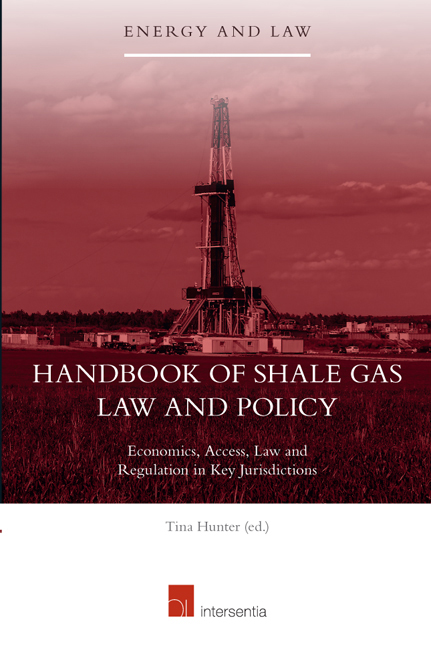Book contents
- Frontmatter
- Preface
- Contents
- List of Tables and Figures
- List of Authors
- Part I Overview and Introduction to Shale Gas Activities
- Introduction
- Shales, Shale Gas and Hydraulic Fracturing
- Hydraulic Fracturing in Shale Gas Operations: Risk and Response in Shale Gas Policy
- Part II Shale Gas Economics and Energy Security
- Part III Access to Shale Gas Resources
- Part IV Shale Gas Law and Regulation
- Part V The Future of Shale Gas in the United Kingdom
- Index
Shales, Shale Gas and Hydraulic Fracturing
from Part I - Overview and Introduction to Shale Gas Activities
Published online by Cambridge University Press: 21 September 2018
- Frontmatter
- Preface
- Contents
- List of Tables and Figures
- List of Authors
- Part I Overview and Introduction to Shale Gas Activities
- Introduction
- Shales, Shale Gas and Hydraulic Fracturing
- Hydraulic Fracturing in Shale Gas Operations: Risk and Response in Shale Gas Policy
- Part II Shale Gas Economics and Energy Security
- Part III Access to Shale Gas Resources
- Part IV Shale Gas Law and Regulation
- Part V The Future of Shale Gas in the United Kingdom
- Index
Summary
INTRODUCTION
This chapter considers the geological and geotechnical issues surrounding the extraction of unconventional oil and gas, especially shale gas, which has already proved a game-changer in the US with access to cheap energy and also the associated petrochemical feedstock, Ethane. These involve new technological processes such as horizontal drilling and hydraulic stimulation (fracking). These are not especially new technologies; however, issues associated with climate change, especially the perpetuation of a dependence on hydrocarbonbased fuels and a number of real and perceived environmental issues, such as groundwater contamination, enhanced atmospheric Methane emissions and minor earthquakes during hydraulic stimulation have caused concern with governments, regulators and the public. This chapter describes the geological environments in which shales form, the conditions which produced shale gas and its exploitation and unpacks some of the issues associated with these issues and examines the best available evidence on their impacts.
While reinforcing the need for as much Carbon as practicable to be left in the ground forever, the recent IPCC report states:
‘GHG emissions from energy supply can be reduced significantly by replacing current world average coal-fired power plants with modern, highly efficient natural gas combined-cycle power plants or combined heat and power plants, provided that natural gas is available and the fugitive emissions associated with extraction and supply are low or mitigated (robust evidence, high agreement). In mitigation scenarios reaching about 450 ppm CO2eq concentrations by 2100, natural gas power generation without CCS acts as a bridge technology, with deployment increasing before peaking and falling to below current levels by 2050 and declining further in the second half of the century (robust evidence, high agreement).’
The Chairman of IPCC Working Group III subsequently stated that the shale gas revolution can be very consistent with low-carbon development and helpful as a bridging technology. This is particularly relevant for Europe with its ambitious goals to shift to renewables and decrease the use of carbon-intensive energy sources with the European Commission setting firm targets to reduce carbon emissions by 40% of 1990 levels by 2030.
- Type
- Chapter
- Information
- Handbook of Shale Gas Law and PolicyEconomics, Access, Law and Regulation in Key Jurisdictions, pp. 13 - 40Publisher: IntersentiaPrint publication year: 2016



